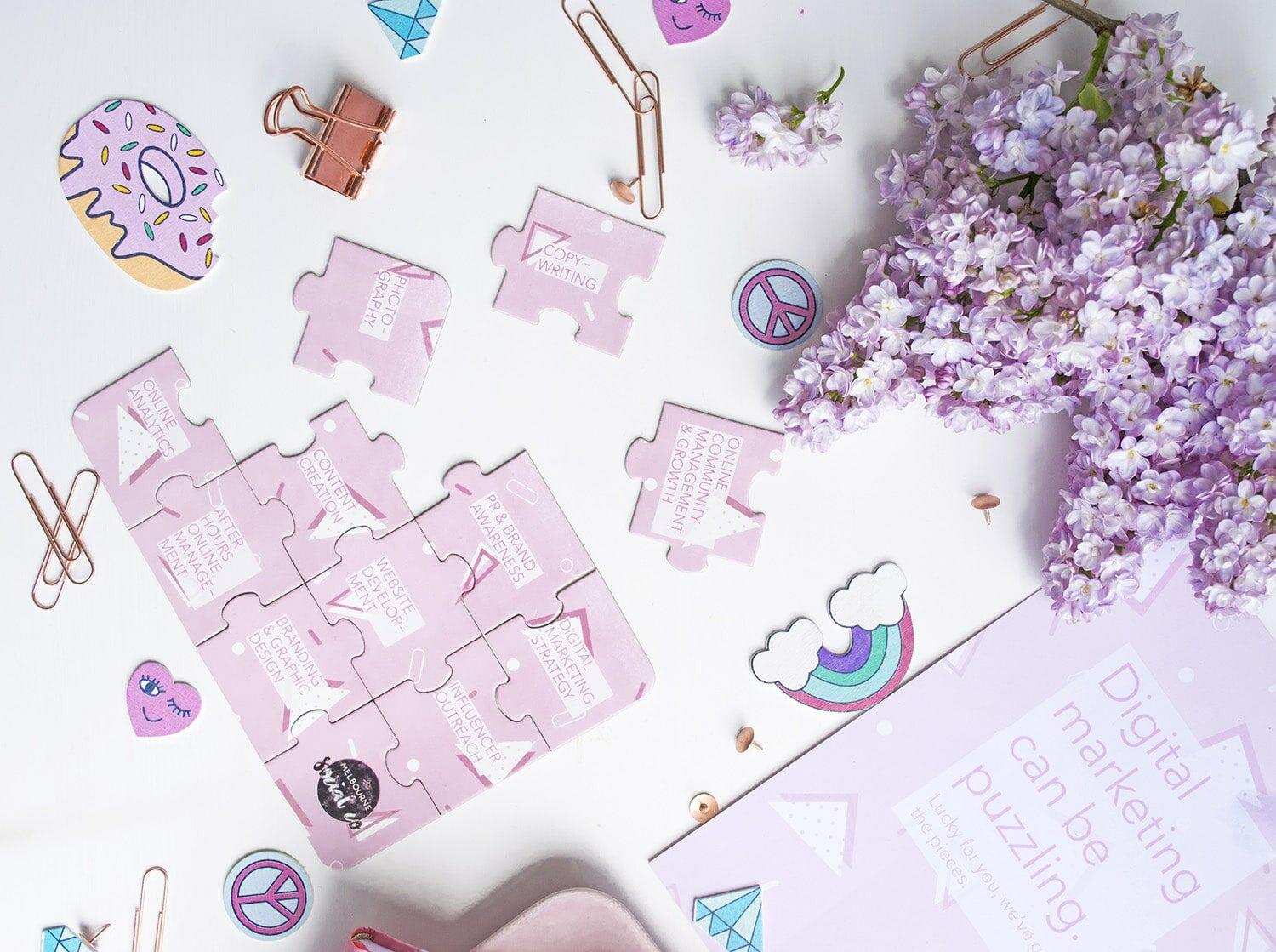8 Reasons To Hire A Social Media Manager
Thinking about whether to manage your social media accounts in-house or to outsource to a professional?
We're sharing a few points on why it's a good idea to outsource your social media management requirements to a professional or agency.
1. Content creation
Having a professional manage your social accounts opens the door to amazing, expert content creation. Not only will your content be creative and of a professional standard, it will also be visually consistent and add to the overall aesthetic of your social pages.
2. Stay ahead of the trends
When you work with a professional, you're tapping into their years of broad experience in social media! It's your social media manager's job to stay up to date with all of the latest digital trends and they will adapt this knowledge to your business.
3. Consistent & professional tone of voice
It is very important when managing a social account, that the tone of voice of the account is consistent and professional. If a social account is managed internally and shared around amongst a team, the tone and professionalism of posts will differ. However, if the account management is outsourced, it will prevent variation in tone and keep the entire account consistent and professional.
4. Increase engagement
Managing your social media account is a daily task, but it can sometimes come second to the day-to-day tasks you have when running a business. Having a pro managing your social media means that no comment will go unanswered and social media can stay a priority without taking away time from the business. Not only will this make your business more personable and real, but it will increase your engagement rates, which will lead to your content appearing higher in your followers' feeds.
5. Reliability
Want to remove any unnecessary worry from your day? With a dedicated professional managing the account you can depend on them to post at the right times and provide a reliable account to engage with followers - this includes after hours!
6. It’s a time saver
Who doesn’t love saving time? By hiring a professional to head your social media it’s one less thing you, as a business, need to do. With your social accounts in more than capable hands, it gives you time to focus on other pressing matters.
7. Accountability
The great thing about using a professional to manage your socials is the level of accountability they bring. Clients expect a certain level of responsibility when outsourcing and a professional will record and measure the work their doing. This helps them meet the client’s needs and also holds them accountable for the work their doing.
8. It’s Fun
To put it simply, social media is fun, especially to those who have made it their career. By hiring a professional to manage your social media, you are guaranteed a committed worker who absolutely loves what they're doing.
Ready to outsource your social media requirements to a professional agency? We're here to help! Contact us at [email protected] today.

Common Social Media Marketing Terms Decoded
If you’re involved in digital marketing, chances are you’ve heard terms like ‘SEO’, ‘engagement' and ‘analytics’ thrown around, often with no explanations or convoluted descriptions. We’ve put together the complete guide of need-to-know social media marketing terms and what they mean for you and your brand. You’ll be bragging about your EDM strategies, your cost per click and conversion rates in no time with our quick guide of digital marketing definitions!
Common Social Media Marketing Terms
A/B testing
A/B split testing refers to testing multiple ads on your target market, where the social media platform (e.g. Facebook) records your best performing ads, and refines your creative as a result. To undergo split testing, you’ll need multiple creative executions of the same ad (variations in copy, different imagery, differing hashtags), and you can run as many of these variations as you like. The platform you’re advertising on records your audience responses such as reactions, comments, shares, or whether people hide or complain about the ad. Split testing is highly recommended, as it means the ads being shown to your target market are the ads which are most likely to succeed.
Analytics
Social media analytics refer to the statistics gathered from your ad sets, which tell you more about your target market and their social media habits. Your digital analytics will tell you who is engaging with your content, how they’re engaging with it (e.g. are they sharing the content? clicking through to your website? are certain times more popular than others?), and from this data you can make more informed decisions regarding your advertising. Analytics are one of the most valuable resources in forming your marketing strategy, and is a major part of the rise of social media advertising over traditional medias (such as billboards or magazine ads).
Clickbait
‘Clickbait’ headlines or tags are a marketing strategy which aims to drive an audience to a site or external link, through creating intentionally vague & dramatic, sometimes misleading headlines. Examples include: “You’ll never guess what Kim wore!” or “Oprah’s live interview: We’re SHOCKED by what she does next!”.
While clickbait headlines can be effective in encouraging people to click through to the next page, headlines like this can also drive consumer distrust or frustration.
Content creation
Content creation simply refers to the creation of images, text, videos, audio files, or any other content to be shared on social media. A lot of advertising or marketing agencies may offer content creation services, which is done by writers, photographers, videographers, editors, animators and stylists, and is posted strategically to engage an audience with a brand.
Conversion rate
The definition of your ‘conversion rate’ will vary depending on your marketing strategies. For example, if you’re running an ad set to encourage people to sign up for your newsletter, your ‘conversion rate’ will refer to how many people fill out the sign-up form. However if your ad set is designed to redirect people to your website, your ‘conversion rate’ will be a record of how many people have visited your site as a result of your ad. Your conversion rates will usually take into account how many people your ad was shown to, and is used to develop your ‘cost per click’.
Cost per click
Your ‘cost per click’ is a summary of how much your ad’s are costing you for every ‘converstion’. Ideally, you would like your cost per click as low as possible, because this means you are getting a higher ROI. Part of what A/B split testing takes into account is your ‘cost per click’, so the ads which are ultimately run are the most cost effective ads for your page.
EDM’s (Email Direct Marketing)
Email direct marketing is advertising in the form of direct emails to your client base. A common use of EDM’s is to promote an upcoming sale or special offer, inform customers of new products and releases, or simply to create a positive brand image by sending out relevant content. EDM’s usually record how many people click-through on your email, which contribute to your marketing analytics.
Engagement & Reach
‘Engagement’ and ‘Reach’ are two of the most common terms in digital marketing, and are both measures of the success of your ads. Engagement refers to how people respond to your ad, so ‘healthy’ engagement means having a high amount of reactions/comments/reposts for the amount of people who’ve seen your ad, and is usually calculated as a percentage. Reach on the other hand refers to the amount of people who’ve seen your ad. Effective advertising usually means striking the right balance between having lots of people see your ads, but also having those people respond positively to it. Social media marketers will focus on generating engagement or reach depending on your campaign; if you’re launching a new product you might focus on achieving a high ad reach, whereas if you’re encouraging people to attend a local event, your ads may focus on driving engagement.
Impressions
Your ‘impressions’ amongst your target audience are similar to your ad frequency. Impressions simply refers to how often your ads are shown to your target market, which is used to develop your engagement rates & cost per click.
Influencer
An ‘influencer’ is refers to a social media account with a significant amount of followers or likes, usually due to the quality or unique value of their content. Generally, an influencer has a minimum of 10k followers, while a ‘mega-influencer’ usually has at least 100k followers. Some brands use influencers as a highly targeted way of advertising to their particular audiences. Influencer marketing can yield a high ROI (return on investment) and has a good track record of fostering consumer trust. We’ve written another piece about digital influencers, which you can find here.
SEO (Search Engine Optimisation)
SEO (Search engine optimisation) is a popular digital marketing technique, and is usually completed by a digital marketer with specific experience or training in writing for SEO. By choosing specific words or phrases over others, and careful decisions about where these words appear on your site or page, your website may appear before others when consumers are searching for a particular product or service, via a search engine such as Google or Bing. Investing in SEO allows can increase the likelihood of consumers choosing your brand over competitors, however this service can sometimes be expensive, so make sure you review all your analytics if you take this path!
Want to pencil in some time to chat to our team about your marketing strategy in 2018? Contact us at [email protected] or visit our Consulting Sessions page to make a booking.

The real cost of buying likes and followers
If you’ve ever been frustrated or disappointed by a lack of followers or likes on your page, chances are you’ve considered purchasing followers on your Facebook or Instagram platforms. At first, this may seem like a simple solution: it’s a small cost and you now have a heap of followers! If users see your online popularity that’ll attract genuine customers, right?
This is the logic that platforms selling followers would promote. The reality is, purchasing likes and followers is not only wasted money, but is detrimental to your analytics, and can create distrust amongst your target audience.
One of the reasons social media is such a powerful platform for advertisers is not only the opportunity to reach consumers, but the analytics it provides. If you run your own Facebook or Instagram business page, the reports you can access on who’s engaging with your page are vital for planning any campaign.
In the age of widespread digital advertising, the way to engage with potential customers is tailoring ads to their interests and social media habits. If your reports and analytics are cluttered with disingenuous likes and follows, not only will you be missing out on the analytics of your potential customers, but your advertising dollars will be wasted on wide reach ads (which thanks to the algorithm changes, are less likely for anyone to see).
Another major disadvantage of buying followers is that it can damage consumer trust. If you’re advertising via social media, chances are your target audience includes some tech savvy, regular users, who know what organic brand engagement looks like. If your page has a heap of followers which doesn’t equate to likes and comments, consumers will suspect your followers aren’t genuine, and may deter the users that could have turned into customers.
Ultimately, the main reason your brand is advertising is to attract genuine customers. Having likes and followers is a great measure of how your audience is responding to your content, but the only value behind these likes is to tailor engaging content, which will attract users to your brand. The money spent on buying followers could be spent better on literally anything else: buying props for your flatlays, boosting a Facebook post, even an extra coffee will be better for your brand than followers that have to be bought.
If you’d like to know more about creating great content and reaching your audience, contact us at [email protected]

Why social media content must be engaging in 2018
Why creating and sharing engaging social media content is more important than ever
We are living in a day and age where our train ride to work, lunch time smoothie and evening workout are projected into the digital world. And brands have moved into the world of Instagram and Facebook as a means to further their influence and increase engagement. So much so, that our social media feeds are now flooded with ads and promotions, frustrating users to the point where there has been a decline in usage, particularly on Facebook.
In retaliation, both Facebook and Instagram have changed their algorithm. The algorithm affects where your posts appear on the feed, who sees your content, and therefore your reach and organic engagement.
Through the altered algorithm, the social platforms intend to show content that will encourage meaningful interactions between users. The posts appearing on our social media accounts are now arranged according to the content you are most likely to interact with. This change in the algorithm penalises brands that come across as overly promotional, therefore pushing them to work harder on gaining customers and potential clients attention. Many aspects of user’s online interactions are taken into consideration within the algorithm, but ultimately, content needs to be engaging to further reach and gain followers.
So, what makes a social media post engaging? How can you influence your followers and encourage them to interact with your content? And hence, how can you grow your following and further your reach?
Know your target audience.
And work hard on providing them with content they will take an interest in.
Ensure images, captions and comments are all “thoughtful”. This is vital in maintaining an identifiable persona. “Thoughtful” content is the kind where followers can see the authenticity, value and quality within each online interaction. Your account is a reflection of your brand, consequently, your online interaction must echo your accounts personality.
Encourage interactions on your account. The more interactions occurring on a post and the longer users engage with it, the more people who will see it. Prompting users to comment on your post, through questions or content they can relate to, will encourage conversation within your account.
Utilise your social platforms. Facebook and Instagram will reward you for this and it will also add dimension to your digital identity. Create stories, send messages and comment on other account’s posts. Videos gain more engagement than images and live videos gain 6x more interactions than regular videos on Facebook.
Social media is constantly changing and evolving. Staying informed of the latest changes will help in maintaining a strong digital presence. But, perhaps most importantly, ensure your online interactions reflect the essence of your brand.
“Social media is a way that businesses can humanise their brand. By creating and sharing really engaging content, both internally and externally with your customers, you put a face to your brand which helps develop trust – be it among your team or with your customers." says our Director Shelley, in a recent article.
Make sure every post, comment and like is made with intent and speaks to who you are as a business. Genuine interaction and engagement will always follow.
Want help creating engaging content for your brand? Find out more about our content creation services by getting in touch today.

A Day In The Life Of A Digital Marketer
A Day In The Life Of A Digital Marketer
Our Director Shelley recently chatted to the team at Fashion Journal about the digital marketing industry and what a typical day looks like.
(Hint, it's not all pretty flatlays and watching cat videos.)

Want to know more about joining our team at Melbourne Social Co? Visit our careers page to see our available positions.
Top digital trends for 2018
2017 saw Instagram prevail, augmented reality grew in popularity and sponsored ads became a huge brand priority. What digital trends will we see in 2018? We want you to be ahead of the curve so here are some digital trends we think you should keep an eye on in 2018:
- Video
Video content is huge. It was last year and it will be this year too with most consumers preferring to consume content in video format. All social media platforms are investing in video content to help generate engagement and increase followers. It is expected that by 2020, 80% of consumer internet traffic will be made up of video content, so if video isn’t already in your social plan, put it in there folks. You’ll thank us later!
- Messaging apps (chatbots)
A chatbot is a software application built to stimulate human conversation. Many brands are utilising this software to assist in responding to consumer enquiries. Some consumers prefer this form of communication over email and phone calls because you get instantaneous updates and answers. But proceed with caution! Automated chatbots can take away from the connections you're building with your fans on social media and can make your brand appear less genuine.
- Augmented reality (VR)
Augmented reality is a fascinating trend. From Google Glass and Pokémon Go to face filters, consumers are intrigued by the idea. Snapchat and Instagram have capitalised on this trend, with consumers loving their AR capabilities (most in the form of face filters). You’ve no doubt seen Snapchat’s dancing hot dog too...1.5 billion other people have too. With new phones like the iPhone X using facial recognition and augmented reality technology, there’s no doubt that this trend will continue to grow.
- Live streaming and ephemeral content
Live streaming started its surge in 2017 and will continue to grow this year. 82% of consumers would rather watch a live video over reading a blog or written social media update. Instagram and Facebook both support the format with their ‘live stories’ making it easy for your brand to jump on board the trend. Ephemeral content is also growing in popularity. This is short-lived content that disappears (usually after 24 hours). Audiences like ephemeral content because it’s more authentic than planned content.
- Influencer marketing
Influencer marketing is one of the fastest growing marketing channels and it’s not hard to see why. Did you know that 49% of Instagram users rely on recommendations from influencers? Building relationships with influencers is something brands should be focusing on in 2018 as influencers become more selective about who they work with.
Before you start addressing these new digital trends and implementing them into your digital plan, it’s important to take time to reflect and learn what worked and what didn’t last year. If you’d like some help analysing your digital performance last year or would like to set up a new digital plan for 2018, shoot us an email, or enquire about a consulting session.

Managing social media over the holidays
Managing your social media presence over the holidays: what you can do now to plan ahead!
You’ve worked hard all year...you’re craving a holiday and can’t wait to take a break from corporate life. Phone on silent, cocktail in hand, feet dipped in the pool. Sounds like a dream...can we come?! But wait...what about your social media accounts? Who will look after them while you’re busy unwinding? Social media never sleeps and consistency is key. Correct! So, we’ve come up with some tips to help you manage your social media presence over the holiday season.
Plan, plan, plan. Planning ahead is key. Sure you’ll have to work your butt off up until your holiday break begins but you’ll definitely thank yourself later! Think of what you want to do and achieve over the holiday season. How many emails will you be sending out to subscribers? Are you launching a new product? Are you planning a huge sale? Write all this information down so you know what you’re striving for.
Create content now! Content creation takes time so set aside some one-on-one time with your camera and computer to put together some amazing content your followers will love. Having a bank of images ready to caption and schedule is invaluable come holiday time. Create some short, fun little videos to engage your audience. They’ll be sick of seeing ‘SALE’ images and baubles in every second photo on their social feeds, so grab their attention by giving them something new and exciting to look at.
Schedule away! Scheduling programs will be your godsend. They make life 110% easier. Facebook is great because it allows you to schedule content on the platform itself. For other social platforms like Instagram, you’ll need to use an external scheduling program to plan your content. Some examples include; Hootsuite, Later and Buffer. You will have to spend quite a bit of time adding each piece of content to the schedule, but your future self will forever be in debt when all you have to do is press ‘publish’.
Yes, a dream holiday would mean zero responsibilities and ever flowing cocktails but if you’re a business owner, you may have to succumb to checking your social accounts every now and then just to check in. Respond to comments, direct messages and do a bit of good ‘ol community management. 10-15 minutes out of your day isn’t so bad hey!
We hope these tips will help in the lead up to the Christmas period where all you want to do is relax!
Do you envisage this next month being a tough one? Do you think you’d prefer to have someone else manage your social accounts? Shoot us an email; we’d love to help!
Build your email database through social media
Is your email list looking a little dismal? Do you desperately want to turn your social followers into subscribers who will then become loyal customers? Sounds like a dream right? Not anymore! Here we share some of our top tips to building your email database through social media.
Share an incentive for those who subscribe
Make it worth their while for signing up! Many e-commerce stores offer a discount of 10%-20% on the next purchase. Alternatively, you could offer a free sample, a coupon or exclusive content. These are great ways to encourage people to subscribe because hey, who doesn’t love a discount or freebie!
Email only offers
Supplying exclusive, premium content in exchange for an email address is a tried and tested technique. For example, offering early access to a mid-season sale or a new e-book would be perfect. This creates excitement and a need to be ‘in the know’. Current subscribers might share this with their friends and family, which will lead to more subscribers. Winning! Additionally, to make this exclusivity known, make the followers on your social channels aware that they’re missing out on amazing offers. This should entice them to sign up!
Host a competition
Hello freebies! Hosting a giveaway is a great way to grow your subscribers. If you’re thinking about running the contest on Facebook, make the call to action a sign up to the mailing list. You can promote the competition on your other social channels too; just make sure to add a link to a page where the audience can subscribe. Here is one way to run the competition; anyone who provides his or her email address will receive a competition entry. You can also encourage your followers to share the competition with their network, possibly offering them additional entries for doing so.
Implement a Facebook sign-up button
If you haven’t already, you should add a sign-up button to your business Facebook page. This call to action button will take the user to a landing page on your website where they can subscribe to your mailing list. The sign up button is near the top of the page so its easily visible to your audience and they’re more inclined to click on it!
If you’re looking for a little more help when it comes to email marketing, shoot us an email and we can give you a helping hand.
Create, Credit, Copyright
Don’t get us wrong, the Internet is a wonderful platform that has leveraged marketing opportunities for thousands of brands and created a whole new industry for those creatively driven. However, it hasn’t come without some bad practices largely due to ignorance and laziness. If you haven’t figured it out by now, we’re talking about copyright.
Did you know that if you create something original, whether it be music, written work or a photo, your work is protected under Australian Copyright Law? This protection is instantaneous from the moment of creation and no copyright registration is required. What many people don’t realise is that this law extends to content that is posted to social media. Have you ever come across an Instagram #inspo account or seen a photo credited with ‘image via pinterest? If you have, then it’s likely you’ve come across content that is breaching federal legislation.
Social media, particularly Instagram, is a platform that encourages people to share content and inspiration. However, in some scenarios, people have taken the sharing culture a little too far by claiming other’s content as their own.
To ensure that you are following social media etiquette, we have put together a few tips that will help you to keep your feed honest, reputable and legal.
- Ask permission to regram the original content creator’s image by simply sending them a quick DM. Most people are more than happy for you to share their content as long as you tag them in the photo and credit them in the caption.
- Tag and credit! Be sure to always tag and credit the content creator in both the caption and the image tags. This way you’re never misleading anyone.
- If in doubt or you can’t find the original content creator, consider whether you really need to post that particular photo.
Why not have a go at trying to create your own content. We’ve shared plenty of handy tips and tricks in our ‘Mastering the #flatlay’ online course to help you get started.
A guide to using hashtags on social media
Hashtags are a way of life in 2017.
In fact, the hashtag is so recognised that it was added to the Oxford dictionary in 2010!
But, despite the fact that we all know what they are, many small business owners are yet to unlock their benefits when it comes to promoting their businesses.
The right hashtag, (or combination of hashtags,) will increase the reach and exposure of your content. And by making yourself more discoverable on social media, you’re increasing your chances of attracting new followers, increasing engagement, and ultimately, increasing awareness for your brand.
Not sure how to make the most of hashtags on social media?
Our friends at The Social Co Academy and sharing their top hashtag do’s and don’ts in a new eBook. Click here to download it now.









